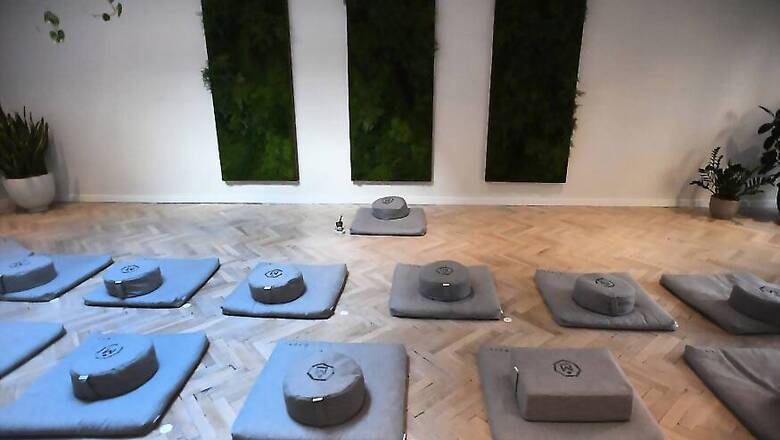
views
It is 5 pm, otherwise known as rush hour in Manhattan.
Julia Lyons, 31, finishes work and heads straight for her daily dose of peace and quiet -- half an hour at meditation studio "Mndfl."
Since April 2016, when she discovered the then-brand new studio, the investment bank employee has abandoned yoga and embraced meditation.
"I have been meditating pretty regularly -- probably five times a week, 30-minute sessions," says Lyons, sipping a cup of tea on the studio's sofa.
"I just need a moment to chill out. This city -- you are always running place to place and there are not a lot of quiet spaces," she explains.
"I think it's made me a lot happier and also just helped me make better decisions, more thoughtful decisions."
Practiced by millions around the world, meditation promotes mental wellbeing through concentration, breathing techniques and self-awareness.
For a long time, those singing its praises were intellectuals, celebrities or people dedicated to spirituality.
Its popularity in the West is owed in part to the Beatles, who promoted the practice on their return from India in the late 1960s.
But these days, meditation can be found in all areas of life -- from hospitals exploring its benefits for patients with serious illnesses, to schools who recommend it for children and television shows.
The craze is a result of many factors -- waning attendance at places of worship, lives spent submerged in smartphones, not to mention neuroscientists' confirmation of the benefits.
As a result, demand is spreading across American cities -- perhaps a natural continuation of the yoga craze, which firmly embedded the search for nirvana in the health and wellbeing industry.
$10 for half an hour
Lodro Rinzler, Mndfl's 34-year-old "chief spiritual officer," opened his first studio in Greenwich Village at the end of 2015, and now owns two others in Manhattan and Brooklyn. Elsewhere in the US, studios can be found in Los Angeles, Miami, Washington and Boston.
Introduced to meditation as a child by his parents, who converted to Buddhism in the 1970s, he says business "is going well."
"The people who come here are really a cross section of all New Yorkers," he explains.
"If the common denominator is, 'I am really stressed out, I need to know how to deal with my mind' -- that's basically everyone."
Rinzler refuses to talk money, revealing only that classes are often full -- and the 75 numbered pads in his studios have been reserved online 70,000 times in just 18 months.
The reason for success? A model offering a well-rounded introduction to this ancient practice for a reasonable price.
For years, Rinzler explains, Buddhist centers only offered long introductions -- sessions of several hours, or even seminars lasting a number of days and costing up to several thousand dollars.
With classes priced at just $10 for half an hour, and options for unlimited subscriptions, new studios in New York or Los Angeles hope to capture a wider audience.
Their model is similar to gyms, but with "zen" in abundance -- including dimmed lights, plant walls, and unlimited organic tea.
CEOs join, employees follow
Companies are also reaping meditation's benefits. More and more organizations in Silicon Valley and other sectors are introducing employees to the practice, convinced of the long-term benefits for the workforce.
Emily Fletcher, an ex-actress who has taught meditation since 2012, launched a special program for companies 18 months ago.
Starting from 150 students in the first year, she now has over 7,000 -- and hopes to reach tens of thousands more with online courses, including in medium-sized cities such as Cleveland, Ohio or Tallahassee, Florida.
"The most common way that I find myself teaching at companies is I teach the CEOs to meditate, and they start to benefit and they bring me on to do a talk with the company," Fletcher, CEO of Ziva Meditation, says.
Employees take part on a voluntary basis, mostly "for some selfish reasons," the 38-year-old explains.
"Either they want to speak better, please their boss, want to make more money or have better sex..."
But Fletcher insists she has no issue with people starting out of self-interest.
"If you actually practice you will start enjoying your life more, your brain will function better, your body will feel better, you get sick less often," she says.
"Those altruistic things will happen as a result of the practice anyway."
Mobile meditation
Another aspect of the industry gaining traction is meditation apps.
One of the most popular, Headspace, had already been downloaded more than 11 million times in the spring -- and boasts over 400,000 paying users.
But meditation's newfound popularity is of such high intensity, neither Rinzler nor Fletcher is concerned about competing studios popping up over time.
"I am sure they are going to be exactly like yoga studios, you are going to find them on every block..." Rinzler predicts.
"If you look at it as a business, there is competition," Fletcher reflects, adding, "if you see it as a mission, there are colleagues."
"There are not too many teachers when it comes to teaching four billion people in my lifetime!"



















Comments
0 comment